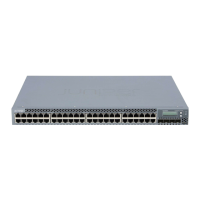Uplink Ports
Each EX3300 switch has four autosensing uplink ports. You can use the uplink ports on
the switch to:
•
Connect an access switch to a distribution switch
•
Interconnect member switches of a Virtual Chassis
The uplink ports labeled 0 and 1 (interfaces ge-0/1/0 and ge-0/1/1 or xe-0/1/0 and
xe-0/1/1) are configured by default as network ports. To use uplink ports 0 and 1 to
interconnect Virtual Chassis members, you must configure them as Virtual Chassis ports
(VCPs).
The uplink ports labeled 2 and 3 (interfaces ge-0/1/2 and ge-0/1/3 or xe-0/1/2 and
xe-0/1/3) are configured by default as VCPs. You can use these uplink ports to
interconnect Virtual Chassis members. To use uplink ports 2 and 3 as network ports, you
must configure them as network ports.
The uplink ports support SFP and SFP+ transceivers. For a list of supported transceivers,
see “Optical Interface Support in EX3300 Switches” on page 29.
Power over Ethernet Plus Ports
EX3300 switches are available in models with or without PoE+ capability. Models that
support PoE+ provide that support on all network ports.
PoE+ ports provide electrical current to devices—such as IP phones, wireless access
points, and security cameras—through network cables, thus eliminating the need for
separate power cords for those devices.
NOTE: IEEE 802.3af and IEEE 802.3at powered devices require category 5
or higher Ethernet cables.
Related
Documentation
EX3300 Switch Models on page 4•
• Site Preparation Checklist for EX3300 Switches on page 41
EX3300 Switch Models
The EX3300 switch models are available:
•
With 24 or 48 network ports
•
With or without PoE+ capability
•
With front-to-back or back-to-front airflow
•
With AC or DC power supplies
Table 1 on page 5 lists the EX3300 switch models.
Copyright © 2011, Juniper Networks, Inc.4
Complete Hardware Guide for EX3300 Ethernet Switches

